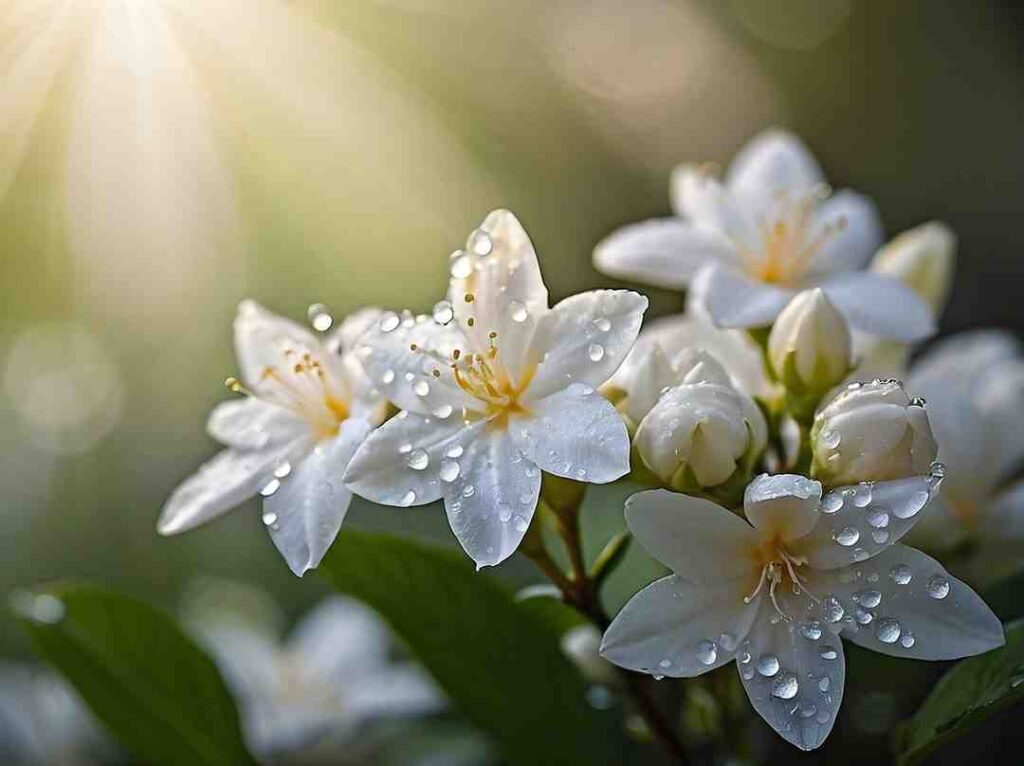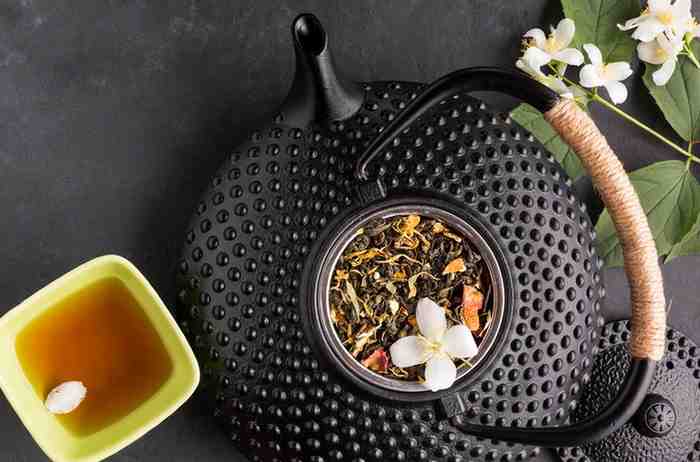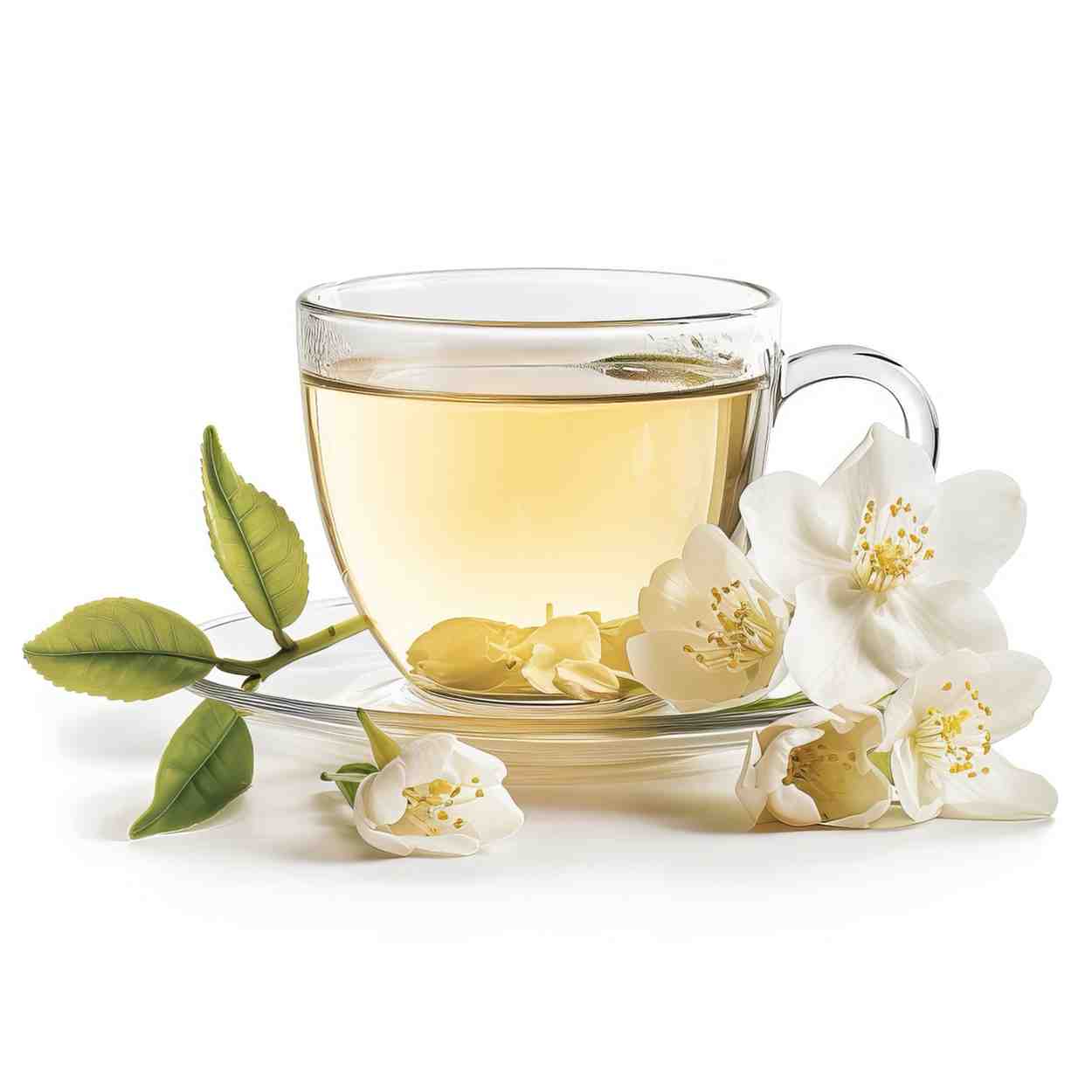Jasmine tea has enchanted tea lovers for centuries with its delicate aroma and refreshing taste. This blend combines high-quality tea leaves with the fragrant jasmine flower, creating a sensory experience that appeals to both traditional and modern audiences. Originating in ancient China, jasmine tea has become a symbol of relaxation and wellness across the globe.
- Widely consumed in East Asia: Countries like China, Japan, and Vietnam embrace jasmine tea as part of their daily rituals.
- Known for its soothing properties: The floral notes offer a calming effect, making it ideal for unwinding.
- Combines tradition and modernity: Its popularity spans from traditional tea houses to contemporary cafés around the world.
A Moroccan Twist: In Morocco, mint tea is occasionally enhanced with fragrant additions such as jasmine, bitter orange blossom, rosebuds, or saffron pistils. These floral elements elevate the tea’s aroma and flavor, creating a luxurious and aromatic experience. The choice of flowers often depends on regional traditions and availability.
Origins and History of Jasmine Tea
The history of jasmine tea stretches back to ancient China, where the combination of tea and floral scents became an art form. This unique blend emerged during a time when tea drinking evolved from a daily habit into a cultural practice.
Ancient Beginnings in China
Jasmine tea began in China during the Song Dynasty (960–1279 AD), when the practice of scenting tea with flowers took hold.
- Initial Creation: Tea artisans placed fresh jasmine flowers over tea leaves, allowing the blossoms to infuse the leaves with their scent. This process required patience and skill.
- Cultural Significance: In Chinese culture, jasmine symbolizes purity and grace. Its use in tea-making aimed to enhance the sensory pleasure of drinking tea.
- From Elite to Everyday: Initially, jasmine tea remained a luxury for the upper class, but it quickly spread among the general public. Its light, floral flavor became a favorite in households across China.
The scenting process involved placing fresh jasmine flowers over the tea leaves multiple times, usually at night when the flowers bloomed. The repeated layering ensured that the tea absorbed the full aroma of the jasmine. This meticulous approach helped make jasmine tea a sought-after commodity in ancient China.

Spread to Neighboring Countries
As trade routes expanded, jasmine tea found a home in other parts of East Asia, including Japan and Vietnam. Its spread not only involved commerce but also represented a cultural exchange between these regions.
- Journey to Japan: Jasmine tea reached Japan through trade and became popular among those who appreciated its delicate taste. While green tea remained the standard, jasmine tea offered a pleasant variation.
- Adoption in Vietnam: Known as “Trà Lài,” jasmine tea in Vietnam became a staple for both social gatherings and traditional ceremonies. Vietnamese tea masters adapted the scenting process, using locally grown tea leaves and flowers.
- Introduction to the West: In the 19th century, jasmine tea began to appear in European markets. Western consumers, intrigued by its exotic aroma and health benefits, embraced this new addition to their tea collections.
The journey of jasmine tea from China to other regions demonstrates its universal appeal. Each country adapted the tea to fit its local traditions while maintaining the essence of the original blend.
Jasmine Tea in Different Cultures
Jasmine tea holds a special place in the cultural practices of many countries. Each region has developed its unique methods for enjoying this aromatic beverage, reflecting their customs and preferences.
Cultural Significance in China and Taiwan
In both China and Taiwan, jasmine tea symbolizes more than just a drink; it represents tradition, hospitality, and connection.
- Tea Ceremonies: Jasmine tea is often a part of Chinese tea ceremonies, where the focus is on appreciating the aroma, flavor, and color of the tea. These ceremonies emphasize mindfulness and relaxation.
- Symbol of Hospitality: Serving jasmine tea to guests shows warmth and respect. The delicate fragrance of the tea enhances the atmosphere of any gathering.
- Everyday Enjoyment: Beyond ceremonies, jasmine tea serves as a daily refreshment in Chinese homes and tea houses. Its mild taste makes it a popular choice throughout the day.
In Taiwan, jasmine tea holds similar significance. Tea houses in Taiwan serve jasmine tea alongside traditional snacks, creating a space for social interaction and quiet reflection. The practice of sharing a pot of jasmine tea encourages a sense of community.
Modern Popularity in Western Countries
In recent years, jasmine tea has gained a strong following in Western countries, where it is prized for its taste and health benefits.
- Health-Conscious Choices: Many in Europe and North America choose jasmine tea for its antioxidant properties and calming effects. It is often marketed as a natural remedy for stress and digestion.
- Blending with Modern Trends: Jasmine tea has become a key ingredient in iced teas, bubble teas, and even tea cocktails. Its floral notes pair well with fruity flavors, making it a versatile choice for creative drinks.
- Easily Accessible: Today, jasmine tea is available in supermarkets, tea boutiques, and online shops. Its accessibility has made it a staple in Western households, bridging the gap between tradition and modern convenience.
Jasmine tea’s ability to adapt to different cultural preferences while retaining its core qualities has helped it become a beloved drink worldwide.

Brewing and Serving Jasmine Tea
Brewing jasmine tea is an art that requires attention to detail. A properly brewed cup captures the delicate balance between the tea leaves and the floral notes of the jasmine. Beyond preparation, the way it’s served can elevate the entire experience, whether enjoyed hot or cold.
How to Brew the Perfect Cup of Jasmine Tea
Brewing jasmine tea involves a specific process that brings out its best qualities. To ensure a fragrant and flavorful cup, follow these steps closely:
- Choose the Right Tea: Select high-quality loose-leaf jasmine tea or jasmine pearls. This ensures that the tea retains its aromatic oils and natural flavors.
- Heat the Water: Use fresh, filtered water. Heat it to a temperature of 160–180°F (70–80°C). Avoid boiling water, as it can damage the delicate jasmine scent and result in a bitter brew.
- Measure the Tea: Add 1 teaspoon of loose-leaf jasmine tea or 3-4 jasmine pearls per cup into a teapot or infuser.
- Steep Correctly: Pour the heated water over the tea leaves and let it steep for 3–5 minutes. Steeping for too long can make the tea taste bitter.
- Serve and Enjoy: Strain the tea into a glass or porcelain teacup to preserve the aroma and appreciate its light yellow color.
- Tip: For a stronger flavor, use more tea leaves rather than extending the steeping time.
- Tip: Jasmine tea pairs well with light snacks like fruit or sweet pastries.
By following these steps, you can achieve a perfect balance of flavor and aroma in every cup of jasmine tea. It’s a ritual that invites you to slow down and savor the moment.
Serving Jasmine Tea the Traditional Way
Serving jasmine tea is as important as the brewing process. Traditional practices elevate the experience, making it a moment to be cherished, whether alone or in the company of friends.
- Use of Glass and Porcelain: In Chinese and Taiwanese tea traditions, glass or porcelain teapots are preferred for serving jasmine tea. These materials preserve the heat and allow you to appreciate the clear, vibrant color of the tea.
- Small Cups for Better Taste: Serve jasmine tea in small cups to enhance the experience. The smaller size allows you to enjoy the tea’s aroma with each sip, making the tea-drinking experience more immersive.
- Accompaniment with Snacks: In East Asia, jasmine tea is often served alongside light snacks like mooncakes, rice crackers, or dried fruits. This pairing complements the tea’s floral notes and creates a balanced tasting experience.
Modern adaptations include serving jasmine tea chilled or infused with fruits for a refreshing twist. These variations cater to different palates while preserving the essence of the tea.
Health Benefits of Jasmine Tea
Jasmine tea is not only a treat for the senses but also offers numerous health benefits. From boosting metabolism to supporting heart health, this aromatic tea provides a range of advantages that can improve your well-being.
Antioxidant Properties and Disease Prevention
Jasmine tea, especially when made from green tea, contains powerful antioxidants known as polyphenols. These compounds help protect the body from oxidative stress and inflammation, which are linked to chronic diseases.
- Rich in Catechins: Catechins like EGCG (epigallocatechin gallate) found in green tea help neutralize free radicals, reducing the risk of cell damage.
- Supports Heart Health: Regular consumption of jasmine tea may lower bad cholesterol levels and improve blood circulation, reducing the risk of heart disease.
- May Help Prevent Cancer: Some studies suggest that the antioxidants in jasmine tea could play a role in preventing certain types of cancer by inhibiting the growth of cancerous cells.
These antioxidant properties make jasmine tea a valuable addition to a balanced diet, offering protection against a variety of health issues.
Cognitive and Mental Health Benefits
The combination of caffeine and the amino acid L-theanine in jasmine tea makes it a powerful ally for cognitive function and mental clarity.
- Improves Focus and Concentration: Caffeine in jasmine tea provides a gentle energy boost, while L-theanine promotes relaxation without drowsiness. Together, they enhance focus and alertness.
- Reduces Stress Levels: The calming scent of jasmine has been shown to lower heart rate and induce a sense of calm. Drinking jasmine tea can help alleviate anxiety and improve mood.
- May Protect Against Cognitive Decline: Antioxidants like EGCG may reduce the risk of neurodegenerative diseases like Alzheimer’s and Parkinson’s by protecting brain cells from damage.
These mental health benefits make jasmine tea an excellent choice for those looking to maintain a balanced state of mind while staying alert.
Digestive and Immune System Support
Jasmine tea can also support digestive health and strengthen the immune system, making it a versatile wellness beverage.
- Promotes Healthy Digestion: Drinking jasmine tea after meals aids in digestion, helping to prevent bloating and indigestion. The polyphenols in the tea support gut health.
- Boosts Immune Function: The antioxidants and catechins in jasmine tea can enhance the body’s immune response, making it easier to fight off common illnesses like colds and flu.
- Combats Inflammation: Regularly drinking jasmine tea may reduce inflammation throughout the body, contributing to overall better health.
These benefits make jasmine tea a practical choice for daily consumption, offering both flavor and function.
FAQs About Jasmine Tea
Many people have questions about how to enjoy jasmine tea and what benefits it offers. Here are some of the most frequently asked questions, along with concise answers to help you make the most of this fragrant tea.
What is Jasmine Tea Made From?
Jasmine tea combines traditional tea leaves—most often green, but sometimes black or white—with fresh jasmine flowers. The flowers infuse their fragrance into the tea leaves, creating a floral, aromatic blend.
Is Jasmine Tea Good for Weight Loss?
Yes, jasmine tea can aid in weight loss. The caffeine and catechins in the tea can boost metabolism and improve fat oxidation, helping the body burn more calories. Drinking jasmine tea as part of a balanced diet can support weight management.
Does Jasmine Tea Have Caffeine?
Jasmine tea does contain caffeine, though the amount varies depending on the base tea used. Green tea-based jasmine tea typically has lower caffeine levels compared to black tea blends, making it suitable for those seeking a gentle energy boost.
Can Jasmine Tea Be Consumed Daily?
Yes, jasmine tea can be enjoyed daily. It provides a range of health benefits without the risk of overconsumption when taken in moderation. Drinking 2-3 cups per day is generally safe for most people.
What is the Best Way to Store Jasmine Tea?
Store jasmine tea in an airtight container, away from light, moisture, and strong odors. This will preserve its delicate fragrance and flavor for a longer period, ensuring a fresh cup every time.

